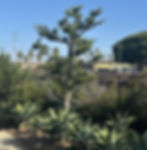TREES, PLEASE! Travel Advisory – PODOCARPUS SPECIES
- k-england
- 5 days ago
- 3 min read
By Tim Clancy, for Let’s Talk Plants! November 2025.

Travel Advisory – PODOCARPUS SPECIES
Destination: Coastal Region of Encinitas, California
Advisory Level: Level 3 – Exercise Increased Caution
Summary: Podocarpus specimens are advised to exercise increased caution when choosing the coastal area of San Diego County as permanent growing locations due to inhospitable drought conditions and highly alkaline irrigation water and soil. A full and useful service life is only possible when cared for by knowledgeable people.
Details:
Weather: The coastal climate is absolutely wonderful and is the reason so many visitors like Italian stone pines, Chinese pistache and crepe myrtles call Encinitas home.
Health & Safety: Be on the lookout for the Podocarpus aphid and the California Red Scale. The usual warnings about planting depth and irrigation regime apply as well.
Light: Full sun to partial shade is available.
Local Guidelines: Based on our (The Chartreuse Appreciation Society) survey it is a “crap shoot” if your destination will serve you. Be particularly wary of “professional” gardeners who mean well.
Recommendations:
Consider a botanical garden if there are any openings.
Estate gardeners are often knowledgeable, follow the money.
Keep an eye on local alerts for sudden pest infestations.
Avoid assignment to a municipality at all costs.
In the city of Solana Beach, California, starting at Via del la Valle and heading south to Loma Santa Fe is the Solana Beach Coastal Rail Trail. It’s a great walking, running and biking trail and has some great landscaping. There are also some inspiring local art and very creative stonework.

One of the plants used in the landscape scheme is an African Fern pine, Afrocarpus falcatus. It goes by other botanical synonyms as well, most notably Afrocarpus gracilior, Podocarpus gracilior and Taxus falcatus. Additional common names include conifer, common yellowwood and around San Diego we usually call it and its close relative “podocarpus”. It is very commonly used as a screen and hedge. Under the right conditions even occasional shearing for a formal look is tolerated. It is a pretty functional conifer.
The Urban Forest Ecosystem Institute describes it as follows:
“…Its leaves are narrow and needle-like, giving it a somewhat feathery appearance. The bark is smooth and grayish-brown, often developing a textured pattern with age. It grows relatively fast and can reach impressive heights, making it a striking focal point in urban landscapes. This tree is well-suited for both large gardens and public parks, offering year-round greenery and a touch of elegance. Its resilience to various environmental conditions adds to its appeal for city settings... …and is restricted to tropical eastern and southern Africa.”

Over the last several years the trees at the Rail Trail have not fared well in general. Early on they started to take on Seussian characteristics as a result of being pruned in all manner of shapes. Why? We can rule out irrigation as an issue as all the neighboring plant material is doing well and not showing any signs of drought. I have noticed on a few plants the telltale signs of chlorosis with the yellowing of the leaves. But that has been more localized rather than sitewide. That’s an indication of a fertilization regime that is working as advertised. I am pretty much convinced that the real culprit is the soil and the irrigation water pH is a limiting factor.


